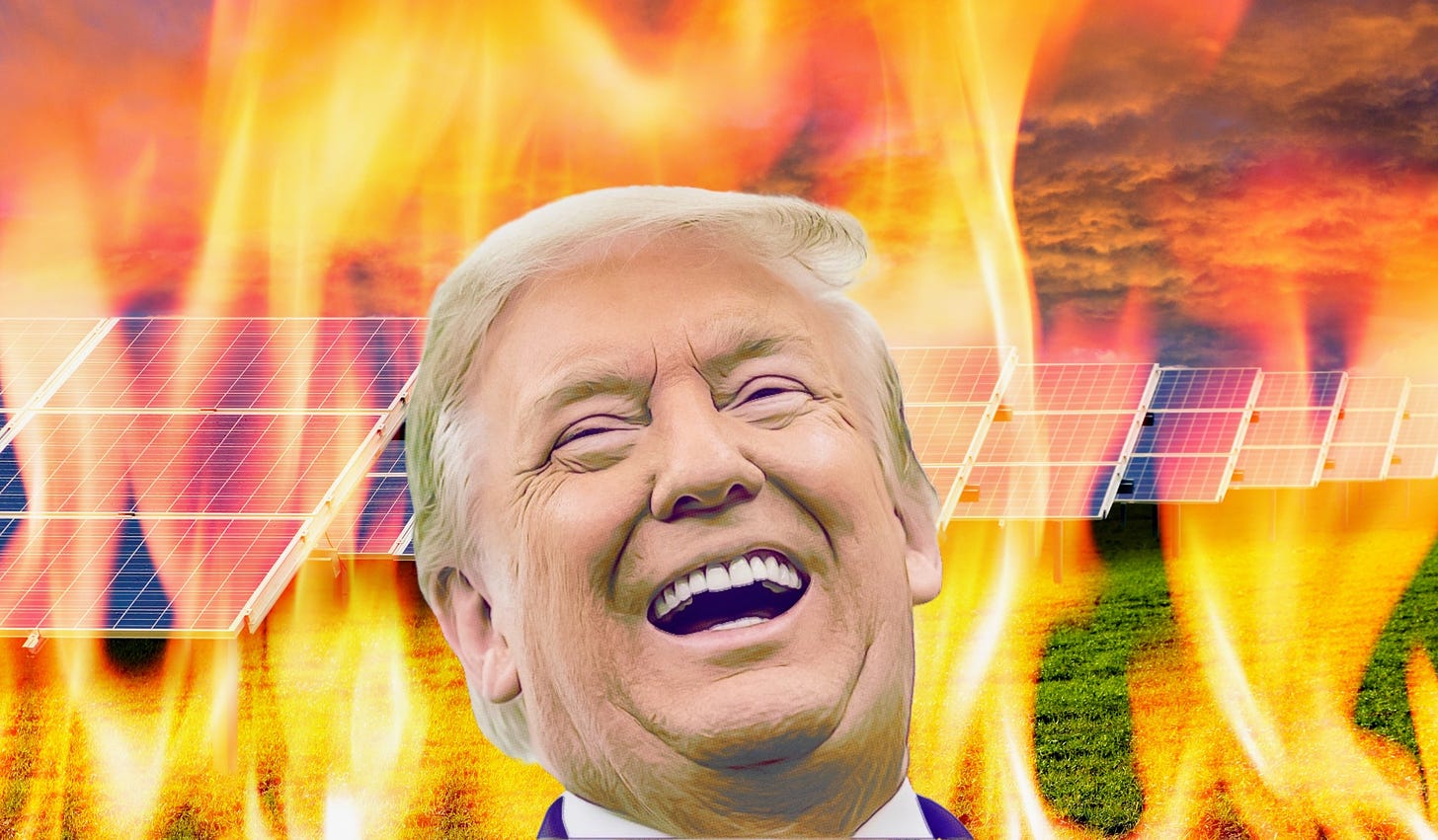How bad could Trump be for renewables?
A previously unreported study predicts a massive decrease in solar, wind, and battery development if Trump adopts just one proposal in Project 2025.
This story is part of HEATED’s series on Project 2025. To read all the stories, check out our series announcement.
It’s often said that a Donald Trump presidency could be bad for renewable energy. But how bad could it be, exactly?
We recently came across a detailed but redacted study answering that very question, published by one of the world’s largest dedicated power market analytics companies in September. It hasn’t yet been reported on by any major or mainstream news outlet, so we reached out to the study authors at Aurora Energy Research who allowed us to view an unredacted version.
Here’s the good(-ish) news: as long as Trump doesn’t touch tax credits for wind, solar, and battery storage, the analysis says his presidency should only have a “limited” negative impact on the energy transition: 25 gigawatts (GW) fewer renewables than under a business-as-usual scenario by 2040.
But here’s the bad news: if Trump does repeal those tax credits—as both he and Project 2025 have proposed—the analysis says a “significant slowdown in the pace of the energy transition” would occur.
Specifically, a Trump presidency could hinder solar, wind, and battery deployment by 212 GW by 2040 if tax credits are ended next year, according to the report.
212 GW is, for context, a huge amount of renewable energy development to lose out on. It is enough to power 159 million homes—more than all the homes in the U.S.
According to the Department of Energy, preventing the development of 212 GW of renewable power and batteries would be like preventing the build-out of 400 million solar panels; 62,328 utility-scale wind turbines; 21,836 offshore wind turbines; or 106 Hoover Dams.
Preventing these renewable projects would also have a massive impact on the climate. According to the analysis, simply removing those tax credits would add 1.8 billion metric tons of CO2 equivalent to the atmosphere by 2040. That’s the equivalent of running 463 coal plants for one year, or running 31 coal plants for the next 15 years.
That amount of pollution “would basically make it impossible to meet the global warming reductions under the Paris Climate Accord,” said Johanna Neumann, senior director for the renewable energy campaign at the climate nonprofit Environment America. Experts have warned that the world needs to stop burning fossil fuels by 2050 to avert the worst impacts of the climate crisis, including deadly hurricanes like Helene and Milton.
“As more and more Americans suffer the impacts of climate change, the benefits of renewable energy become that much clearer,” she said.
The likelihood of a “Project 2025” scenario
In Aurora’s analysis, the scenario where Trump is elected and repeals renewable energy tax credits is called the “Project 2025 scenario.”
That’s because Project 2025, the blueprint for Trump’s second term published by the conservative Heritage Foundation, proposes eliminating all government incentives and tax credits for solar, wind, and battery projects—while keeping the billions in subsidies for the fossil fuel industry.
Aurora’s researchers deem the Project 2025 scenario “extreme,” in part because they don’t believe it’s a likely outcome. “We do not think this will be feasible or likely, given the Republican party's low likelihood of gaining a Senate supermajority and the bipartisan support these clean energy subsidies enjoy,” report co-author Lizzie Bonahoom told HEATED via email.
If Trump did this, researchers note, he would have to “ignore opposition from red state communities” who have benefitted from incentives in the Inflation Reduction Act, President Joe Biden’s landmark climate law. Red states are currently the biggest beneficiaries of the law’s renewable incentives.
Repealing tax credits for renewables also “may not prove popular with consumers,” the analysis says, “since fewer renewables leads to an increase in wholesale power prices up to 22 percent in the most impacted regions like Texas.”
But Trump could do this, Aurora explains, if he feels “pressure to finance a massive $4.6 trillion extension of 2017 tax cuts.” Many of the tax changes that Trump implemented during his presidency are expiring at the end of 2025. The implication is that Trump could increase taxes on renewable developers to finance an extension.
Some environmental policy experts think this idea isn’t so farfetched. “Trump has been very clear about his extreme agenda,” said Leah Stokes, an associate professor of political science at the University of California, Santa Barbara, referring to Trump’s promise to “drill, drill, drill” on his first day in office. “Given the detailed roadmaps in Project 2025 to dismantle our environmental institutions, I have no doubt that he will do everything in his power to try to roll back our clean energy laws.”
Trump himself has claimed to know nothing about Project 2025. But at least 144 of its contributors worked on Trump’s campaign, transition team, or administration, including former Trump political appointee and federal energy commissioner Bernard McNamee, who wrote the chapter proposing to cut tax incentives for renewables.
And Trump’s campaign’s rhetoric and policy platform do echo some of Project 2025’s ideas on renewable energy. Agenda47, Trump’s official policy platform, promises to “immediately stop all Joe Biden policies that distort energy markets … including insane wind subsidies.” It doesn’t explicitly mention solar or battery tax credits, but Trump has promised to roll back Biden’s Inflation Reduction Act, which includes a long-term extension of the 30 percent solar tax credit and has directed billions of dollars to support clean energy projects.
Trump’s actual record on renewable energy is mixed. During his first presidential term, Trump raised tariffs on solar panels, blocking an estimated 10.5 GW of solar energy; delayed the Vineyard Wind offshore wind project by ordering more environmental reviews; repealed the Clean Power Plan that would have accelerated renewable energy development; and attempted (but failed) to cut funding for the DOE office that oversees renewable energy.
He also, however, approved the Gemini Solar Project in Nevada, the largest solar energy project approved on U.S. public lands at the time; and signed laws extending tax credits for renewable projects delayed by COVID-19.
The Trump campaign did not respond to HEATED’s request for comment.
The other “extreme” scenario: A Green New Deal
There is one thing that could stop Trump from scrapping clean energy tax credits altogether: Congress. Even if Republicans win control of both the Senate and the House, which multiple forecasts say is unlikely, more than a dozen House Republicans have already said they won’t repeal them because the investments are benefiting their districts.
“I don't have a crystal ball, but I think it's unlikely at this moment that all of the clean energy tax credits created by the Inflation Reduction Act get rolled back next Congress,” said Neumann.
Trump could still limit, delay, or re-allocate IRA funding using his executive powers. But states play an equally important role in clean energy policy. Even the worst-case Project 2025 scenario wouldn’t impact the country equally, especially in states with subsidies. “Areas with carbon prices and state-driven renewable energy targets, such as California and much of the Northeast, are less susceptible to a Project 2025 scenario,” said Bonahoom.
Whatever Trump decides to do while in office, Aurora’s analysis makes one thing clear: the energy transition is likely to slow, and emissions are likely to rise. The only question is how much.
On the flip side, Aurora’s analysis also makes another thing clear: Under a Harris administration, the energy transition is likely to continue, and emissions are likely to decrease. The only question is how much.
Just like Aurora models an “extreme” Project 2025 scenario for Trump, it also models an “extreme” Green New Deal scenario for Harris. Under this scenario, renewable energy tax credits are maintained and states with Democratic governors implement carbon prices. This results in 300 GW more renewables by 2040, slashing 1.6 billion metric tons of carbon dioxide equivalent from the atmosphere.
To be sure, this wouldn’t be enough for the U.S. to achieve its climate goals under the Paris Agreement, which would require 90 percent carbon-free electricity by 2035. To achieve that, the U.S. would have to add a challenging 1,100 GW of new wind and solar generation in the next decade, according to the University of California, Berkeley and GridLab.
Still, the country has made progress: the U.S. is now getting three times more energy from renewable sources than a decade ago. But that rapid growth needs to speed up to preserve a livable climate.
“For the sake of our kids, we have to do everything we can over the course of the next decade to reduce the emissions that are dangerously warming our planet,” Neumann said. “And renewable energy is the best solution we have.”
Related reading:
A Trump presidency would risk $1 trillion in clean energy investment, WoodMac says. Reuters, May 2024
Wood Mackenzie projects about $7.7 trillion in investment for the U.S. energy sector over 2023-2050 under current policies … It would be $1 trillion less if Republicans reverse key policies bolstering low-carbon energy and infrastructure improvements. In 2050, Wood Mackenzie projects, net US energy-related CO2 emissions will be 1 billion tonnes higher compared to what they would be under current policies.
A Trump win puts $369 billion in clean energy incentives at risk, BI says. Bloomberg, June 2024.
A Trump victory could threaten IRA-driven growth, especially for the green energy sector,” BI said in its analysis of the IRA’s future after the US election. “Though a full repeal is unlikely, targeted cuts to tax incentives could be in store.”
Trump administration buries dozens of clean energy studies. Grist and InvestigateWest, October 2020.
In all, the Energy Department has blocked reports for more than 40 clean energy studies. The department has replaced them with mere presentations, buried them in scientific journals that are not accessible to the public, or left them paralyzed within the agency, according to emails and documents obtained by InvestigateWest, as well as interviews with more than a dozen current and former employees at the Energy Department and its national labs.
Catch of the Day: Merkx is a hairy black dog who is worried about how global warming will make it too hot for his old body. He wants us all to keep cool!
Thanks to reader Gregg for the submission.
Want to see your furry (or non-furry!) friend in HEATED? Send a picture and some words to catchoftheday@heated.world






Glad that some Republicans in Congress won't reverse course on renewable energy since they understand what an economic boon it is for their district, but that would be a small consolation amid a Trump presidency. Let's hope, despite its best efforts, the Harris campaign manages to win.
People need to understand that Trump doesn't do anything unless it benefits him personally. If it puts money in his pocket to repeal the tax credits or let them expire, he will do so and vice versa if it benefits him to keep them going. With Trump, you have to follow the money. Nothing else matters to him.